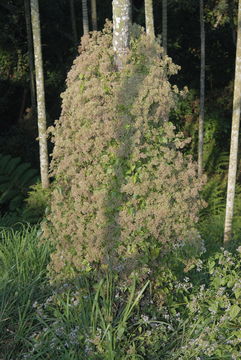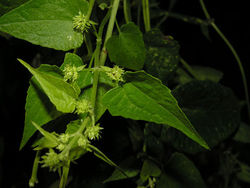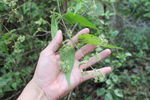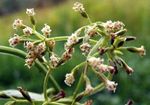Mile-a-minute
| Mile-a-minute |
|---|

|
| Scientific Classification |
|
| Binomial Name |
|
Mikania micrantha |
| M. Micrantha leaves |
The Mile-a-minute weed is a fast-growing annual vine known by the scientific name Mikania micrantha. It thrives in many climates and conditions, but mostly humid areas. It is classified as a problematic invasive species due to its remarkably fast ability to grow and overwhelm other plants. There are a wide variety of mechanical and chemical suppressions, but none have permanently killed off growth. More control efforts are being done today to contain M. micrantha worldwide.[2]
Body Design
The mile-a-minute plant is a tall-growing vine with flowers, a thin stem, and leaves growing in triangular or heart-like shapes.[3] The flowers are white, growing in small bunches nestled between leaves and at the end of branches. The flowers bloom from August to Spring. These fluffy flowers measure from 3-4 milimeters long and grow in pairs of four on a head. They produce black seeds which are elongated and have a ring of white hairs on their surfaces.[4]
The leaves which the flower heads grow around are green and measure 4-13 centimeters long and 2-9 centimeters wide. The leaves grow opposite to each other and can be triangular or heart-shaped. The petiole (stem) which connects the leaf to the vine is long. [5] The main body of this plant is a vine which can grow to be considerably extended. This vine is described as twining (creeping). It has been documented to kill trees as tall as 25 m. [6] It is perennial and the vine branches off into slender stems on which the leaves and flowers reside. The stems occasionally grow roots from their nodes. These stems are ribbed and may be puberulent (slightly hairy) or glabrous (hairless). [7]
Life Cycle
The life cycle of mile-a-minute weed is varied, sometimes listed as an annual (Kasahara, 1954; He et al., 1984), other times as a perennial (Riefner, 1982; Zhu, 1989). It behaves like an annual in North America (Mountain, 1989; Cusick and Ortt, 1987; McCormick and Johnson, 1997).[8]
An annual plant, mile-a-minute is a plant that completes its life cycle, from germination to the production of seed, within one year, and then dies. Summer annuals germinate during spring or early summer and mature by autumn of the same year. Winter annuals germinate during the autumn and mature during the spring or summer of the following calendar year.[9]
A perennial(from Latin per, meaning "through", and annus, meaning "year") plant, mile-a-minute is a plant that lives for more than two years. The term is often used to differentiate a plant from shorter-lived annuals and biennials. The term is also widely used to distinguish plants with little or no woody growth from trees and shrubs, which are also technically perennials. Perennial plants can be short-lived (only a few years) or they can be long-lived, as are some woody plants like trees. They include a wide assortment of plant groups from ferns and liverworts to the highly diverse flowering plants like orchids and grasses. [10]
Ecology
The mile-a-minute best grows in areas of high humidity. Although it best grows in light and soil fertility, it can also adapt in less fertile soils. Its seeds get around in the wind because they are so featherlike. The mile-a-minutes natural habitat is native to the subtropical zones of North, Central, and South America. Its global range expanded to cover Southeast Asia and the Pacific during the 1940s when it was used as camouflage for airfields. It has been observed to grow almost half a meter per week under optimal conditions. It can take over and smother other plant life and even large trees. And left uncontrolled, it can cover entire abandoned areas in a few months. [11] Because of its reaction to high humidity, in germinates near soil seed banks of low land rain forests and fallow soil seed banks. [12]
Being a C3 plant, Mikania can produce a large quantity of biomass in a single life span. It shows an excellent response to high potassium levels in soils and conserves potassium in 'slash and burn' agricultural areas. One thing it cannot tolerate is shade and will not disturb ecosystems in natural forests. It invades low canopy forests due to heavy grazing.
Invasive Behavior
Mile-a-minute is a major weed in Southeast Asia and the Pacific Islands that adapts easily and quickly into its invasive environment. The weed is able to tolerate massively humid and hot temperatures in places such as Brazil, China, Bolivia, and India. Its reproductive potential and wide spread growth assist in its ability to spawn and gain control of forest ecosystems. It soaks up most, if not all, of the light native vegetation use for photosynthesis, causing them to die out and the weed to thrive. In many farms, it attacks crucial crops such as rubber, coconut, and tea. The weed is extremely detrimental to the agriculture of Asia, which causes a drop in produce. [13]
Wind, water, and vector dispersal aid in Mile-a-minute's overtaking. Though it is a very common and highly invasive vine, it is only considered a threat in few countries. It grows in South and Central America and Asia because of the topography's high soil moisture and humid, hot temperatures. [14] In the United States, the estimated cost of controlling the weed was $9.8 million in 1985 for plantations growing rubber, palm oil, and cocoa. In a different study, M. micrantha infiltrated a bamboo plantation, suffocating the young bamboo and became dominant over time. The vine has the ability to climb and entangle native species, which gives it an advantage to surviving. Its natural aggressiveness towards native vegetation reduces the ecosystem's biodiversity. It tolerates, even benefits from common weed-killing measures like fire, cultivation, mutilation, etc. [15]
Control Efforts
Multiple efforts have been attempted to no avail using controlling agents. Figuring out how to control this weed is crucial to not only in controlling this weed, but other invasive plants. Mikania Micrantha is one of the top invasive species. It can take over an entire tree in two days, thus the name Mile-a-Minute. Over time many methods of controlling this plant in such ways as mechanical, cultural, chemical, and biological.[16]
In Ismail, the most popular control method is to roll, dry, and burn the plant, yet was found to be unsustainable due to its toleration of efforts to suppress it. In India ecologists uproot and weed through many miles of plant. These methods,however, are much more expensive than chemicals. Mikania micrantha is vulnerable to some herbicides, and such chemicals (paraquat, glyphosatem and 2,4-D) are used. [17]
Some insects and some fungal pathogens can also eradicate the plant and stop the damage it is prone to cause. In Indonesia, it was discovered that Chromolaena odorata feeds on this plant. These caterpillars eat off its skin but do not significantly harm it. This knowledge may be valuable in the future, however, for controlling efforts. [18]
Video
Florida Department of Agriculture and Consumer Services- Mikania Micrantha
References
- ↑ Mikania micrantha Kunth mile-a-minute USDA Natural Resources Conservation Services. Web. Accessed 08 October 2014. Author Unknown.
- ↑ Compiled by IUCN/SSC Mikania micrantha (vine, climber)Global Invasive Species Database .Web. Last Modified January 24, 2005
- ↑ Compiled by IUCN/SSC Mikania micrantha (vine, climber)Global Invasive Species Database .Web. Last Modified January 24, 2005
- ↑ Mikania vineQueensland Government .Web. Accessed October 6, 2014. Unknown Author
- ↑ Dr. Richard Weaver Mikania micrantha, mile-a-minute Florida Department of Agriculture and Consumer Services.Web. Created January 2010.
- ↑ Mikania Micrantha Invasive Species Compendium .Web. Created October 13, 2014. Unknown Author
- ↑ Mikania micranthaPacific Island Ecosystems at Risk (PIER) .Web. Created January 1, 1999. Unknown Author
- ↑ [1]Anon. 1978. Annual scientific report 1977, Tocklai Experimental Station, Station. Tea Research Association, Jorhat, Assam, India.
- ↑ [2]Kansas Prairie Wildflowers (1980) by Clinton E. Owensby
- ↑ Dorling Kindersley. 2008. p. 1136.[3]
- ↑ Weaver, Richard. Pest Alerts - The Chinese Creeper, Bittervine Or Mile-a-minute, Mikania Micrantha Florida Department of Agriculture and Consumer Services. Web. Updated March 29 2010.
- ↑ Mikania micrantha Invasive Species Compendium. Web. Accessed October 07 2014. Author Unknown.
- ↑ Author Unknown.Mikania micrantha Invasive Species Compendium. Web. Accessed October 07 2014.
- ↑ Author Unknown. Mikania micrantha Invasive Species Compendium. Web. Accessed October 07 2014.
- ↑ Unknown Author. Mikania micrantha Pacific Forest Invasive Species Network. Web. Accessed October 07 2014.
- ↑ Author Unknown. Ecology of Mikania micrantha Invasive Species Data Base. Web. Accessed October 07 2014.
- ↑ Diaz, Rodriguez. Detection of biotic resistance to Mikania micrantha University of Florida IFAS. Web. Accessed October 07 2014.
- ↑ Author Unknown. Mikania micrantha Invasive Species Compendium. Web. Accessed October 07 2014.




